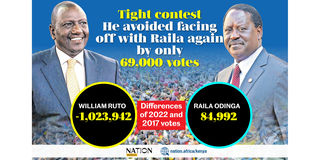Premium
How William Ruto, Raila Odinga fared in strongholds during polls

President-elect William Ruto and his main challenger Raila Odinga banked on their strongholds to secure over two-thirds of their respective national tallies, explaining how the hotly contested race went down to the wire.
Ultimately, the tight contest was decided on the candidate who reaped the most from his rival’s turf and fared better in the fight for the other third of the vote in the election to decide the country’s fifth president.
The two fierce opponents relied on nearly the same number of counties spread out in their respective bastions – Dr Ruto (17) and Mr Odinga (19) to each garner over four million votes in the August 9 elections.
Dr Ruto secured 4.5 million from the 10 Mt Kenya counties and seven Rift Valley counties considered his turf, to post a slight lead over Mr Odinga who scooped 4.3 million in the 19 counties of Coast, Western, Nyanza and Ukambani.
With the Deputy President having a slim head start of 268, 777 as the two fierce competitors turned to scout for votes in the rest of the country considered battlegrounds, this gap would prove vital as ultimately Dr Ruto won the contest narrowly with 233, 211 to avoid a runoff by just 69, 000.
Strongholds
After securing the strongholds, Ruto gained 2.63 million while Raila added 2.67 million but the 35, 000 advantage the ODM leader had proved insufficient to catch up with Ruto.
Mr Odinga has vowed to challenge in court the results announced by the electoral commission’s chairman, Mr Wafula Chebukati that crowned Dr Ruto the winner with 7.1 million or 50.49 per cent of the total vote against his 6.9 million or 48.85 per cent.
Supreme Court judges will decide on the presidential petition that must be filed by 2pm on Tuesday with the verdict to either uphold the election of Dr Ruto as president or order a repeat poll as happened in 2017 when Mr Odinga successfully challenged President Kenyatta’s re-election.
Mr Odinga boycotted the subsequent fresh election won easily by the incumbent but their truce in 2018 would lay the ground for his fifth presidential run under the Azimio la Umoja One Kenya Coalition backed by the outgoing president who fell out with his deputy, Dr Ruto.
In the end, this year’s controversial presidential contest was decided on who ate into his rival’s turf with a bigger margin, and secured significant votes in the rest of the country. The deputy president seemed to have gotten the better of his rival.
In counties at the Coast, Nyanza, Western and Ukambani, which accounted for 61.6 per cent of Mr Odinga’s national tally, the President-elect squeezed out 1.4 million votes. In Busia, Kakamega, Bungoma and Vihiga, Dr Ruto gained 217, 118, nearly the total vote for UhuRuto in 2017. In Western, Dr Ruto garnered 630, 282 votes, close to three times the 242, 000 UhuRuto had in 2017.
Comparatively, Mr Odinga emerged with a million votes from the 10 Mt Kenya and the seven Rift Valley counties that collectively gave Dr Ruto 63.3 percent of his total vote.
Crucially, Mr Odinga managed 22 per cent of the vote from Mt Kenya, a region that has been hostile to his presidential bid.
This time, however, the opposition leader got 848, 205 votes with the backing of President Kenyatta and his wing of the ruling party but the Azimio coalition fell short of its initial target of at least 30 per cent.
And although Dr Ruto, whose United Democratic Alliance (UDA) swept nearly all the seats in the region, lost one million votes compared to their tally on a joint ticket with President Kenyatta in 2017, he still walked away with 77 per cent of the region’s vote.
With one of the lowest turnouts in the region compared to the last two elections, Dr Ruto secured 2.94 million of the 3.82 million valid votes cast, highlighting his success to wrestle the region from President Kenyatta who had opposed his bid to succeed him.
Given the region has 5.8 million registered voters, a higher turnout in case of a repeat election would work to his advantage.
In Nairobi, Dr Ruto lost 229,516 votes from their 2017 tally, while Mr Odinga, who narrowly won the city in 2013 and 2017, lost 61,431 votes from his 2017 tally. Of the 2.4 million registered voters in the capital, Dr Ruto got 561,775, while Mr Odinga had 767,395.
In North Eastern, Dr Ruto dropped 150,581 votes from the UhuRuto tally in 2017, while Mr Odinga gained 193,629.
Mr Odinga improved due to support from Mandera governor Ali Roba’s United Democratic Movement (UDM) – which won six parliamentary seats and two gubernatorial races – and United Party of Independence Alliance (UPIA), associated with Treasury Cabinet Secretary Ukur Yatani.





